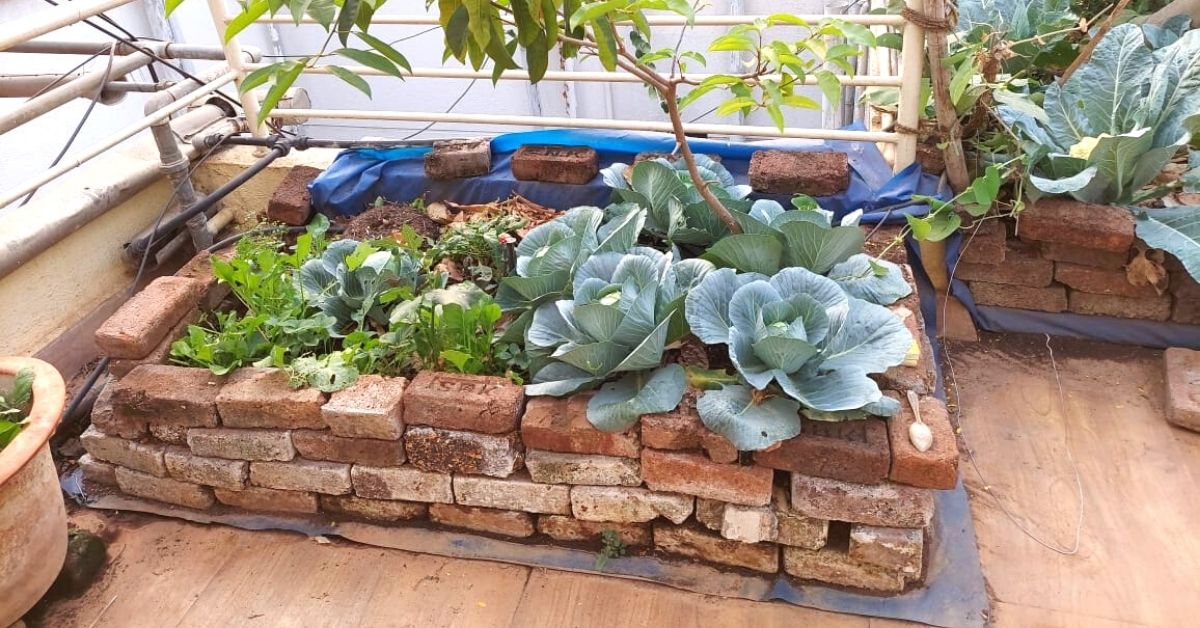Kirti Bhave, an urban gardener from Pune, has been growing vegetables on raised beds since 2012. Raised beds are enclosed structures constructed with wooden stone, concrete, or bricks, with a pile of soil or compost inside. They have multiple advantages, such as maintaining the soil’s pH-value, better draining of the water, assisting aeration, and reducing risk of weeds and infections in plants. And, of course, they look beautiful.
Making raised beds is easy, and one only needs to use simple items within their vicinity. In a conversation with The Better India, Kirti shares three easy steps on how to make one.
Find the perfect location
Before beginning, ascertaining the location of the beds is important, as unlike pots, they are not movable. Kirti suggests setting up the bed in a place that receives at least 5-6 hours of sunlight is ideal.
After identifying the spot, it is important to ensure the roof does not leak because of the soil and moisture spread in the area. “You don’t want the water to seep through the gaps. There is no need to worry if the roof has been applied with waterproofing agents,” she says. But if not, she suggests the simplest way to take care of it is by spreading a 50-micron plastic sheet in the area.

Source the material locally
“Now, place the bricks along the sides, with dimensions of about 4×2 feet. This size makes it easy to manage the space without the need to bend or struggle to attend to the plants,” Kirti explains, adding, “Bricks are easy to find at a construction site nearby. I bought some from the locality.”
Once the bricks are set up, place broken sticks, twigs and bagasse (sugarcane waste) to make the bottom layer for the bed. “Bagasse can be accessed from a farmer or at a traditional dairy farm. The dry decomposable biomass allows the bottom area to remain aerated and allow excess water to drain out easily,” she says. Kirti recommends topping the bottom layer with dry leaves or organic waste.
Soilless mixture
She says the third layer involves adding a mixture of cow dung, kitchen waste, compost and other organic material from the vicinity. “It is okay to use soil, but I do not prefer it in the mixture as it makes the structure heavy. The soilless medium increases the capacity of the bed to carry organic waste. Adding jeevamrut (a mixture of cow dung, cow urine, water, gram flour and jaggery fermented for 2-3 days) at this step is a good practice, and can further enhance the fertility of the compost mixture,” she says.
Kirti suggests forming a 4-inch layer of compost at the top. The compost layer helps plants germinate and maintain a firm grip. She advises to let the mixture settle inside the structure for the next 48 hours. “Ideally, the compost would be ready for use after three weeks. But using it in a couple of days for sowing the seeds also works fine,” she adds. Over the next few weeks, the mixture will reduce by 1/3rd, as the leaves and other organic matters decompose. Kirti suggests refilling the mix by adding dry leaves and flowers.

Aftercare
Raised beds work best to grow leafy vegetables, herbs and flowers. “It can also be used as a composter. I have multiple beds, and I use them alternatively to make compost and grow food on it,” Kirti says.
On how to care for the beds, she says, “Using a plastic sheet for the raised bed can attract snails. It is best to surround the bed with a sour-based solution (like lime or salty liquids) to protect it,” she says. Another important step is to avoid putting cooked food inside the compost. “The cooked food will attract unwanted pests, insects and even rats,” she warns.
“It is likely that many insects and worms become visible on the raised bed. But they are all good, and there is nothing to worry about with the plants or compost. It is because of the microbial activity, and they all indicate a healthy ecosystem,” Kirti adds.
For any queries, Kirti can be contacted on kirtianay@gmail.com.
Edited by Divya Sethu
No comments:
Post a Comment